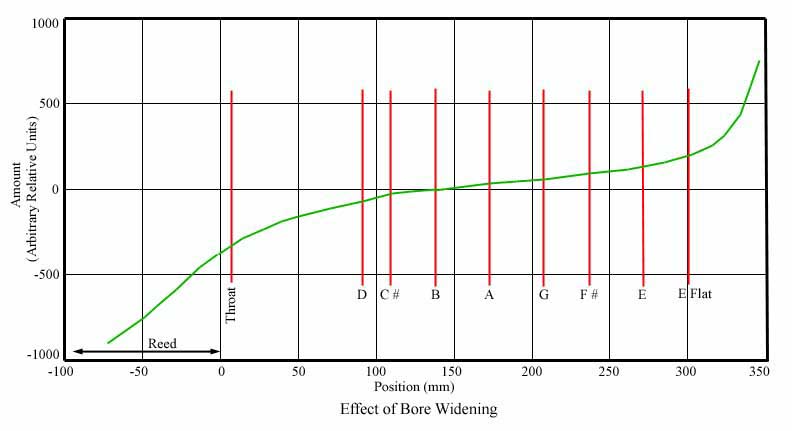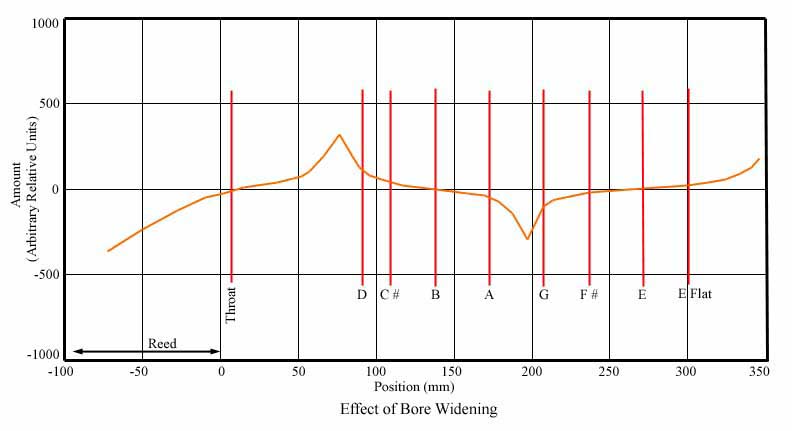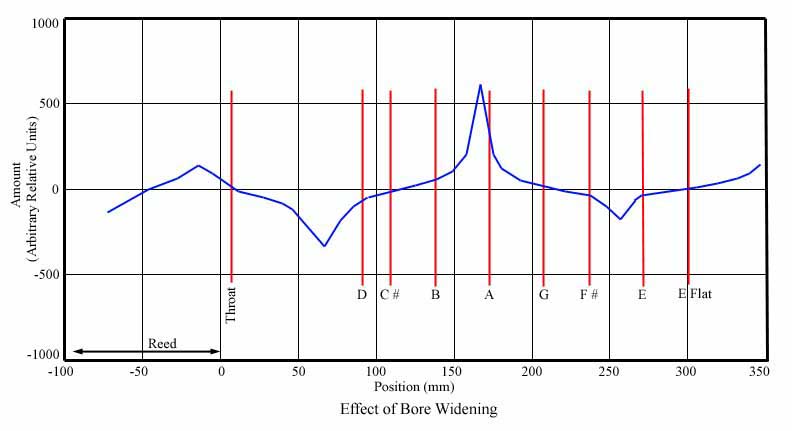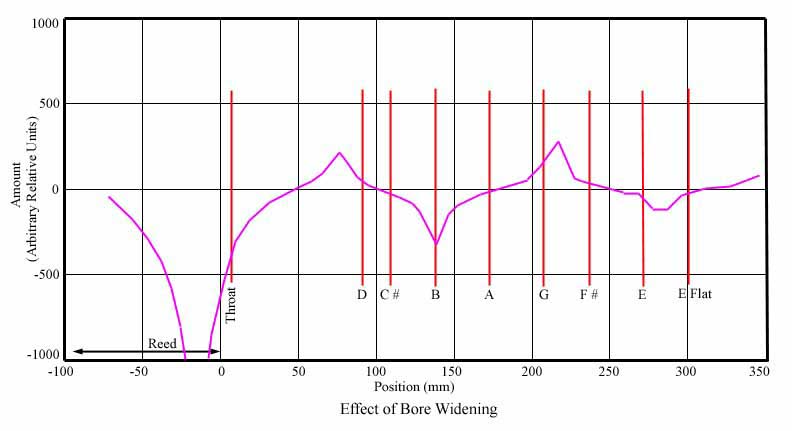
This is a brief explanation based on the article published as: "Pipe Bores and Pipe Acoustics," Craig Fischer, in the book Ceol na hEireann no. 3, 2001, sold by Na Piobairi Uilleann, and I believe earlier around 1998 in An Piobaire.
Every musical note is a blend of multiple pitches called "partials" or "harmonics" that combine to create the tone that identifies the instrument and its musical quality. The pitch that we recognize as any musical note is the lowest harmonic of the blend, so this 1st harmonic is also called "the fundamental." The other, higher-pitched harmonics are multiples of the fundamental. In uilleann chanters, the lowest several harmonics influence the tuning and behavior of the notes, and so when fine-tuning a chanter, we are adjusting the instrument in ways that sharpen or flatten specific harmonics of specific notes.
This can be done by altering many parts of the system: reed blades, staple, toneholes and the bore. Each approach has its drawbacks, and each has unique benefits that the other approaches lack. Modifying the bore lets us move several holes from their natural awkward locations for some designs into positions that are easier for the fingers to reach.
In the 1990's the Australian pipemaker Craig Fischer conducted several types of analysis of quite a few uilleann pipe chanters, drones and regulators. For some studies, tones were sounded into portions of the instruments and the acoustic responses studied; for others, the bore and tonehole geometry were analyzed with established woodwind mathematics. The details are all well beyond my expertise, but from having sent him copies of articles from woodwind science journals, I can affirm that the subject comes reasonably close to rocket science. What was new at that time was affordable high powered personal computers, which allowed the mathematics to be applied to real-life pipes including their bore pertubations, toneholes, real reeds and all.
The following charts are adapted from an early Fischer study of a D chanter. They display the response of specific harmonics to a widening of the bore at any point along the reed-and-chanter system. The horizontal scale shows positions within the reed-chanter system, with the staple and reed tip toward the left in the negative position range, the throat just beyond the zero point, and the chanter bore occupying the dominant positive portion of the scale with the bottom or bell of the chanter to the right around 360 mm, the approximate length of a concert D chanter. The vertical scale is of arbitrary units to indicate the relative amount of pitch change at that location in response to a slightly wider bore. The negative region below the zero axis indicates a flatter pitch, while the positive region indicates a sharper pitch in response to the wider bore.
Note, these charts don't predict how a particular chanter tunes or performs. All they are is maps of the zones where a widening in the bore diameter will make a greater or lesser change in the pitch of the particular harmonic charted. The reason that the studies involve a widening rather than a narrowing of the bore is that localized widening is the method used to fine-tune a wooden chanter. For reamed chanters there is no way to add wood once it has been reamed away.
We have the ability to test these findings easily without altering a chanter, based on the fact that the opposite applies. If the bore is instead narrowed in any region, the pitch of the charted harmonic would change about the same amount as the curve shows, but in the opposite direction indicated on the chart. To test, we can constrict an area of the bore by inserting a short wire or plastic-wire of around 1-1.5" length in the upper bore and about the thickness of a paper clip, or 1.5-2" length wires in the lower bore of the thickness of medium to thick weed-trimmer cord .05"-.1" thick. Start a bit below the indicated position, and test the chanter repeatedly after nudging it a few mm higher, to find the most active zone in your particular chanter for the effect in question.
Craig cautioned me at one point that if a chanter is very troublesome, we may not find some of the active zones.
Here is a chart of the fundamental or 1st harmonic response of bottom D:

The green curve represents the change in pitch of the fundamental or 1st harmonic of bottom D at any given point along the bore if the bore is widened a little at that position. The fundamental gives us the tuning of the normal bottom D note.
We see that it is flattened in pitch when the upper bore and especially the reed are made wider. Through most of the body of the chanter the curve lies near the zero axis, meaning that variations in the bore in that region has little effect on the fundamental. The upward slope at right indicates that as we approach the bell, widening the bore has greater and greater effect, sharpening the fundamental and therefore bottom D at this end.
Here is a chart of the bottom D 2nd harmonic response:

The tan curve represents the 2nd harmonic of the bottom D, and we see that it has a more complex response.
We can listen to the 2nd harmonic or octave of bottom D for testing purposes by fingering bottom D, increasing bag pressure, and then cracking the back D thumb hole very slightly open. This will play the same note as back D but almost always at a slightly different pitch. Ideally says Craig will be a bit flat or at least not sharp of the back D.
This harmonic too is flattened by a wider reed, and then moving along the curve we see it is sharpened by widening just above back D, flattened by widening just above the G hole, and again sharpened slightly by enlargement of the bell.
The 2nd harmonic of any chanter note influences the performance of the 2nd octave note of its hole. In the case of bottom D, we choose not to jump the octave of this note, instead playing 2nd octave D with the back D thumb hole. This allows us to adjust the bottom D to play the hard D sound effect and to play gracenotes and crans without squealing or jumping the octave. One way to make a chanter resist jumping the octave is to make the 2nd harmonic flat compared to the fundamental for that note. This has been done to an extreme in the case of the Highland pipe chanter. If you can force a weak Highland reed to jump the octave at all, it will be painfully flat, sounding like a squeal more than a musical note.
Comparing the 1st and 2nd harmonic graphs, this may explain the traditional bell flare in so many chanters. They show that while a bell enlargement sharpens both the fundamental and the 2nd harmonic, it sharpens the fundamental much more. So if a chanter is designed with a slightly long bell making a flat bottom D, and it is then flared to bring bottom D back up to pitch, the 2nd octave of bottom D will be raised a little less and will remain flatter, increasing its resistance to the octave jump or squeal.
Here is a chart of the 3rd harmonic response of bottom D:

Notice that this response has even more peaks and valleys than the 1st and 2nd harmonics. It's flattened by an enlargement in the top end of the reed, sharpened by an enlargement in the staple, flattened in the upper bore just above back D, sharpened by enlargement just above A, slightly flattened by enlargement just above E, and slightly sharpened by enlargement just above the bell.
The 3rd harmonic of a note sounds a musical 5th in the octave above that note; for bottom D, the 3rd harmonic sounds the same note as A in the 2nd octave of the uilleann chanter. We can listen to this harmonic for testing purposes by fingering bottom D, blowing firmly, and cracking the A hole very slightly open.
Craig reports that this harmonic most influences the pitch of the hard D note. This may be related to the fact that we trigger the hard D response by increasing pressure and quickly cutting with a short A gracenote.
In many modern concert D chanters the hard D is often quite sharp of bottom D. This does not have to be so. I own a "Squinnter" square-bore chanter built by Craig Fischer, and its hard D is very willing and very closely tuned to the normal bottom D without any special reed or bore insertions.
Below is a chart of the response of the 4th harmonic of the bottom D note:

Here we see that the trend continues, each higher harmonic having more active zones for both sharpening and flattening in response to bore enlargement. We see a very strong flattening of the harmonic in the lower end of the staple that in relative sensitivity reaches clear off the chart scale, and then modest sharpening from an enlargement just above back D, flattening from enlargement at B, sharpening with an enlargement just below G, flattening from enlargement between E and E-flat or ghost D, and very slight sharpening from a bell flare.
Craig reports that the 4th harmonic is most important in controlling the stability of hard D, which we also refer to as the infamous "motorboating" gurgling of the bottom D. His article reports that the goal is to keep the 4th harmonic sharp. By far the strongest response of this harmonic is the first one in the lower staple down past the throat, where generations of piper lore tell us to insert a wire rush into the reed staple or a paper wrap inside the chanter throat to stop a gurgling bottom D or hard D.
All these zone of course influence other notes as well, so whether we are finalizing a chanter design or fine-tuning an individual chanter, there will always need to be compromises, and as a general design rule, it is best to modify any particular sound through slight adjustments in as many parts of the system that influence the sound as possible, because each area has different side effects.
Bottom of Hard D Adjusting page.
Corrections, comments to David Daye, send
email here.